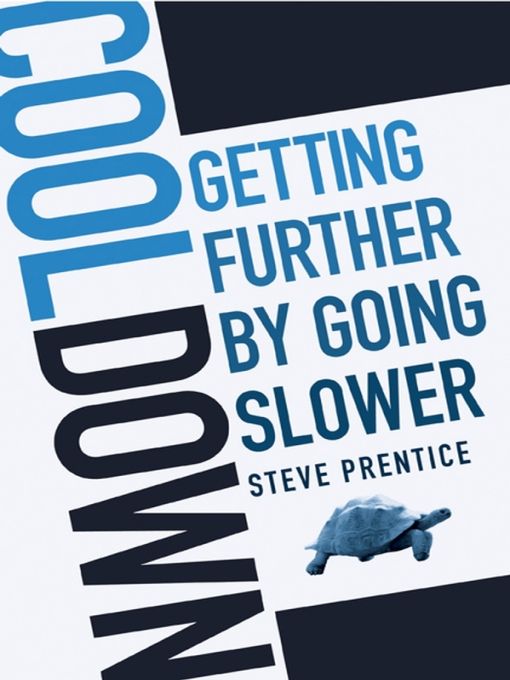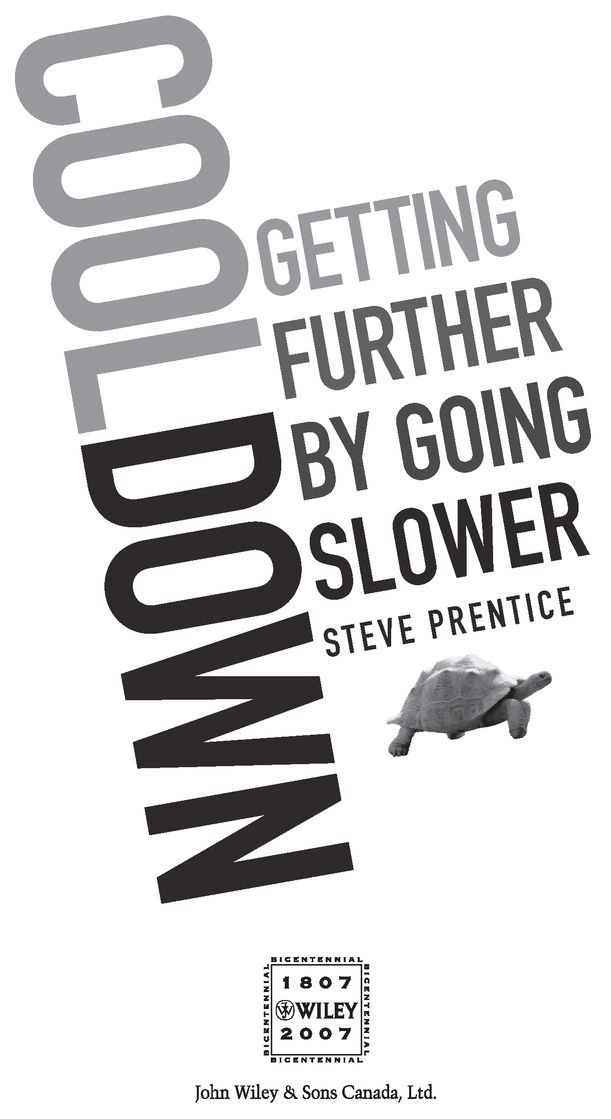Cool Down
Authors: Steve Prentice


Table of Contents
Â
Â
Â
Â
Â
Â
Â
Â
Â
Â
Â
Â
Â
Â
Â
Â
Â
Â
Â
Â
Â
Â
Â
Â

Copyright © 2007 by Steve Prentice
All rights reserved. No part of this work covered by the copyright herein may be reproduced or used in any form or by any meansâgraphic, electronic or mechanical without the prior written permission of the publisher. Any request for photocopying, recording, taping or information storage and retrieval systems of any part of this book shall be directed in writing to The Canadian Copyright Licensing Agency (Access Copyright). For an Access Copyright license, visit
www.accesscopyright.ca
or call toll free 1-800-893-5777.
www.accesscopyright.ca
or call toll free 1-800-893-5777.
Â
Care has been taken to trace ownership of copyright material contained in this book. The publisher will gladly receive any information that will enable them to rectify any reference or credit line in subsequent editions.
Â
National Library of Canada Cataloguing in Publication Data
Â
Prentice, Steven Cool down : getting further by going slower / Steve Prentice.
Â
eISBN : 978-0-470-67531-1
Â
1. Time management. I. Title.
Â
HD69.T54P.1'1 C2006-905935-7
Â
Production Credits
Cover design: Mike Chan
Interior text design: Natalia Burobina
Wiley Bicentennial Logo: Richard J. Pacifico
Printer: Printcrafters
Interior text design: Natalia Burobina
Wiley Bicentennial Logo: Richard J. Pacifico
Printer: Printcrafters
Â
John Wiley & Sons Canada, Ltd.
6045 Freemont Blvd.
6045 Freemont Blvd.
Mississauga, Ontario
L5R 4J3
L5R 4J3
Â
Â
PC
To my family.
Thanks to:
Â
Nancy Carroll, Arnold Gosewich, Dr. Jack Muskat
INTRODUCTION
THE SLOW MOVEMENT: WHO NEEDS IT?Let's get this straight, right from the beginning. This is a book about the
Slow
movement, and whether it has any place in modern business. But this is not a book about how
nice
it feels to slow down and drift through life. It's a book about:
Slow
movement, and whether it has any place in modern business. But this is not a book about how
nice
it feels to slow down and drift through life. It's a book about:
⢠Getting ahead
⢠Getting things done
⢠Staying employable
⢠Staying employed, and it's about
⢠How to do the important things fast.
Fast is important. In an age of 24/7 business, of overloaded schedules, of wireless access and a ceaseless need to stay in the loop, there isn't much tolerance among working people for a Huckleberry Finn approach to managing the dayâlazy afternoons, long lunches, and taking time to observe the sun traverse the sky. We all may wish we could take this approach, but few of us have a realistic expectation of getting there any time soon. There's just too much to do, and it all needs to get done now.
Everywhere you turn you hear people talking about their ever-increasing task load; that the workday has extended to 18 hours or more; that email and wireless PDA devices are addictive and that people are using them, or are feeling pressured into using them, well into the hours that used to be reserved for personal life. This, it seems, is the new norm.
In spite of this, there are others who profess the value of going more slowly. They say they're part of a
Slow
movement. They represent a collection of organizations and individuals that together advocates working slower, speaking slower, eating slower, and basically living slower. Numerous companies, it seems, right here in North America, have actually incorporated
slow
into their infrastructure, changing work hours and office layouts to accommodate in-house daycare, workout rooms, communal meeting places, and privacy nooks. There are cities in Japan, Italy, and elsewhere that have made this
Slow
movement an official lifestyle, mandating traffic patterns, store-opening hours, and even business practices to fit with this philosophy. And, thanks to the Internet, these advocates have all joined together to become a new global-social presence.
Slow
movement. They represent a collection of organizations and individuals that together advocates working slower, speaking slower, eating slower, and basically living slower. Numerous companies, it seems, right here in North America, have actually incorporated
slow
into their infrastructure, changing work hours and office layouts to accommodate in-house daycare, workout rooms, communal meeting places, and privacy nooks. There are cities in Japan, Italy, and elsewhere that have made this
Slow
movement an official lifestyle, mandating traffic patterns, store-opening hours, and even business practices to fit with this philosophy. And, thanks to the Internet, these advocates have all joined together to become a new global-social presence.
So, is this for real? Is the
slow
approach tenable here in North America? Can it work for you, in your business, with your customers and your boss, in a way that will make things better? Sure, the Italian countryside certainly seems a good place to encourage the
Slow
movement. Workers have come and gone across its fields and streets for thousands of years. There's probably a greater readiness there to accept a shifting of gears, since, after all, Old World Europeans have “been there and done that” in so many different ways that their collective sense of time, life, and related values is by now encrusted with pragmatic acceptance. But how realistic is it to expect the
Slow
movement to catch on in those areas of the world where a high-speed work ethic reigns? It goes against instinctâagainst the very forces that have propelled human beings to adapt and advance. The desire to further yourself, to protect yourself and your family from harm, and to identify opportunities to improve living conditions are strong basic urges, and although, ultimately, most people work really hard so that one day they no longer have to work so much, the idea of slowing down to get there just doesn't make sense.
slow
approach tenable here in North America? Can it work for you, in your business, with your customers and your boss, in a way that will make things better? Sure, the Italian countryside certainly seems a good place to encourage the
Slow
movement. Workers have come and gone across its fields and streets for thousands of years. There's probably a greater readiness there to accept a shifting of gears, since, after all, Old World Europeans have “been there and done that” in so many different ways that their collective sense of time, life, and related values is by now encrusted with pragmatic acceptance. But how realistic is it to expect the
Slow
movement to catch on in those areas of the world where a high-speed work ethic reigns? It goes against instinctâagainst the very forces that have propelled human beings to adapt and advance. The desire to further yourself, to protect yourself and your family from harm, and to identify opportunities to improve living conditions are strong basic urges, and although, ultimately, most people work really hard so that one day they no longer have to work so much, the idea of slowing down to get there just doesn't make sense.
Julie Burchill of the
London Times
put it this way: “There is something rather sad about those people always banging on about the joys of Slow Shopping, and of its kissing cousin Slow Food; it points to dull and dreary nostalgia-hounds with too much time on their hands and a morbid fear of modernity ...”
1
London Times
put it this way: “There is something rather sad about those people always banging on about the joys of Slow Shopping, and of its kissing cousin Slow Food; it points to dull and dreary nostalgia-hounds with too much time on their hands and a morbid fear of modernity ...”
1
So what's the answer? Does going slow appeal to you? Does it seem practical, or does it look like a recipe for “second-best”? My belief is that
slow
is not only wise, it is essential. For as the pace of life speeds up, the skills that we need to attract and build business and to maintain a superior level of productivity are getting buried under a false momentum that plays on some very deep-seated fears inside the human mind.
slow
is not only wise, it is essential. For as the pace of life speeds up, the skills that we need to attract and build business and to maintain a superior level of productivity are getting buried under a false momentum that plays on some very deep-seated fears inside the human mind.
Furthermore, there are laws of physics that demonstrate that working faster doesn't get you there faster. But in large part, the digital age has forced us to work faster and live faster, and in so doing we have started to lose sight of the maxim “more haste, less speed.”
The goal of this book, then, is to identify ways in which the concepts put forth by the
Slow
movement can be applied to ensure to your survival and success as a competitive working professional. But for this to make sense, these concepts have to be realistic. When there are 200 emails sitting in your inbox, a wireless PDA chirping on your hip, and a boss or a customer who says, “Just get it done,” slowing down doesn't spring to mind as Plan A.
Slow
movement can be applied to ensure to your survival and success as a competitive working professional. But for this to make sense, these concepts have to be realistic. When there are 200 emails sitting in your inbox, a wireless PDA chirping on your hip, and a boss or a customer who says, “Just get it done,” slowing down doesn't spring to mind as Plan A.
It's important to make the point here that not everything that is quick is bad. Responding quickly to a client's call might win new business. Solving a client's problem quickly might generate greater loyalty. Getting out of the way of a falling piano is a healthier option than just standing still. Quickness is vital to competitiveness and to survival. But quickness and quality cannot be fully achieved if everything else about your work and your mental state is hurried to the point of confusion or exhaustion. And that's why I believe this book will be valuable to you.
Cool Down
seeks to model its success strategy after people and even creatures who know the value of going slow in order to go fast. The cheetah, for example, is the fastest animal on earth. The cheetah knows so much about being
fast
primarily because she also knows about going
slow
. She knows she cannot run 70 miles an hour all day and still expect to make a catch. She knows her own strengths and weaknesses as well as those of her quarry, and is thus better empowered to strike at the right time, in the right measure.
Cool Down
seeks to model its success strategy after people and even creatures who know the value of going slow in order to go fast. The cheetah, for example, is the fastest animal on earth. The cheetah knows so much about being
fast
primarily because she also knows about going
slow
. She knows she cannot run 70 miles an hour all day and still expect to make a catch. She knows her own strengths and weaknesses as well as those of her quarry, and is thus better empowered to strike at the right time, in the right measure.
Other books
Unwrapped by Katie Lane
She's With Me by Vanessa Cardui
Tangle of Need by Nalini Singh
Fragrant Flower by Barbara Cartland
Betrayal by Will Jordan
Special Delivery by Amanda Bretz
Musician's Monsoon by Brieanna Robertson
Killer Getaway by Amy Korman
Dark Tide (A Mated by Magic Novel) by Stella Marie Alden, Chantel Seabrook
Give Me Your Heart by Joyce Carol Oates